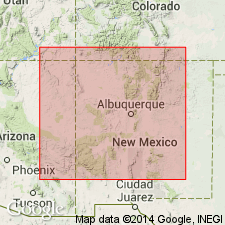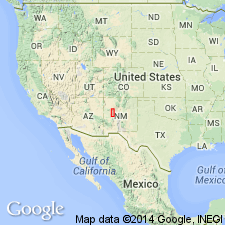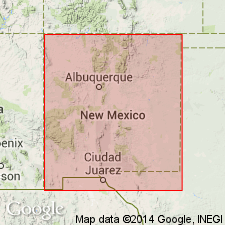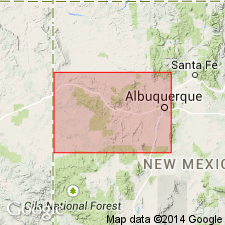
- Usage in publication:
-
- Pescado tongue
- Modifications:
-
- Named
- Dominant lithology:
-
- Sand
- Shale
- AAPG geologic province:
-
- San Juan basin
Summary:
Named as a tongue of the Mancos shale for "typical" exposures on north side of valley of Pescado Creek, below Pescado village, sec 32, T11N, R17W and sec 5, T10N, R17W, Zuni Indian Reservation, McKinley Co, NM in the San Juan basin. No type locality designated. Divides the Gallup member. Section 50 ft thick measured at Pescado Creek where member is divisible into (ascending): 10 ft covered interval; 5 ft of gray shaly sand with shale partings and abundant carbonized plant remains; and 35 ft of dark-gray, fossiliferous (ammonites), marine shale. Splits the Gallup into two parts. In the measured section: the lower contact of the Pescado is placed at top of massive, tan, cliff-forming sandstone of Gallup member of Mesaverde formation; the upper contact of Pescado placed at base of interbedded gray shale and gray soft sandstone of Gallup member. The fossils PRIONOTROPIS HYATTI, OSTREA LUGUBRIS, and INOCERAMUS FRAGILIS in the measured section indicate a mid-Carlile age. Pescado reported to be 170 ft of sandy shale on Alamosa Creek. Thins northward and southward from Pescado Creek. Distribution suggests deposition in a local marine embayment during a transgressive phase. Block diagram; measured sections; geologic map; cross section; correlation chart.
Source: GNU records (USGS DDS-6; Denver GNULEX).

- Usage in publication:
-
- Pescado tongue*
- Modifications:
-
- Not used
Summary:
A marine shale in the Alamosa Creek Valley area, Ts2 and 3N, Rs7, 8 and 9W, Socorro Co, NM, Orogrande basin, beneath the Gallego sandstone member may be a higher tongue in the Mancos than the Pescado tongue of the type locality, McKinley Co, NM, San Juan basin. Thus the name Pescado tongue of Mancos is not used and the shale is named D-Cross tongue of the Mancos. Of Late Cretaceous age. Measured sections. Geologic map.
Source: GNU records (USGS DDS-6; Denver GNULEX).

- Usage in publication:
-
- Pescado Tongue*
- Modifications:
-
- Revised
- Overview
- Areal extent
- AAPG geologic province:
-
- San Juan basin
- Orogrande basin
Summary:
As a tongue of Mancos Shale disconformably overlies Fite Ranch Sandstone Member (new) of Tres Hermanos Formation (raised in stratigraphic rank) between Atarque, Valencia Co, San Juan basin and Cebollita Mesa, Socorro Co, Orogrande basin. Can be recognized where the F sandstone of Gallup Sandstone occurs. Southeast of Cebollita Mesa equivalent rocks are part of D-Cross Tongue of Mancos. Is of Late Cretaceous age.
Source: GNU records (USGS DDS-6; Denver GNULEX).

- Usage in publication:
-
- Pescado Tongue*
- Modifications:
-
- Age modified
- Biostratigraphic dating
- Overview
- AAPG geologic province:
-
- San Juan basin
Summary:
Is tongue of the Mancos Shale in the Upper Nutria area of San Juan basin in west-central NM, where it is considered equivalent to part of the Juana Lopez Member of the Mancos farther north. Overlies Fite Ranch Sandstone Member of Tres Hermanos Formation. Overlain by Gallup Sandstone. Only 3 molluscan species (all bivalves) have been identified from the unit by the authors: INOCERAMUS DIMIDIUS, I. cf. FLACCIDUS, and LOPHA LUGUBRIS. According to authors, the unit "probably lies in the early late Turonian zones of PRIONOCYCLUS MACOMBI and P. WYOMINGENSIS, but if the record of P. HYATTI by Pike (1947, p. 34) is correct, the member may include some of the P. HYATTI zone" [late middle Turonian]. Figure 2 is stratigraphic nomenclature and correlation chart of middle Cenomanian to lower Coniacian rocks in west-central NM, spanning 20 ammonite zones.
Source: GNU records (USGS DDS-6; Denver GNULEX).
For more information, please contact Nancy Stamm, Geologic Names Committee Secretary.
Asterisk (*) indicates published by U.S. Geological Survey authors.
"No current usage" (†) implies that a name has been abandoned or has fallen into disuse. Former usage and, if known, replacement name given in parentheses ( ).
Slash (/) indicates name conflicts with nomenclatural guidelines (CSN, 1933; ACSN, 1961, 1970; NACSN, 1983, 2005, 2021). May be explained within brackets ([ ]).

